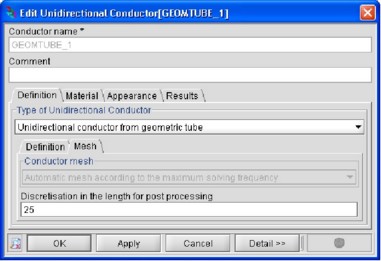Isovalues: about
Plotting of isovalues
Spatial scalar quantities can be displayed with color shaded isovalues on different supports.
For spatial vectorial quantities the modulus as well as the components can be displayed with isovalues.
Support
The support for the plotting of isovalues is always a surfacic support. In Flux PEEC, the supports available are:
- external surfaces of unidirectional conductors
- external surfaces of bidirectional conductors
- 2D grids
Computation algorithm
The computation of isovalues is done in two steps:
- first, the spatial quantity considered is calculated at some relevant points of the support surfaces; these points depend on the physical quantity considered, but in general they are highly linked to:
- for unidirectional conductors, to the mesh and the additional points due to the discretization in the length for the post processing *
- for bidirectional conductors, to the mesh
- for 2D grids, to their own discretization as described in § 2D grids: about
- then, an interpolation algorithm makes it possible to compute the quantity considered at intermediate points enabling the smoothing of the isovalues

Spatial quantities
The spatial quantities that can be displayed with isovalues are:
- the modulus and the three components (X, Y and Z) of the current density
- the Joule losses density
- the modulus and the three components (X, Y and Z) of the magnetic flux density
- the modulus and the three components (X, Y and Z) of the Laplace force density: the average component or the 2ω pulsating component